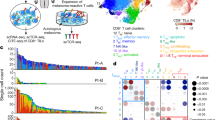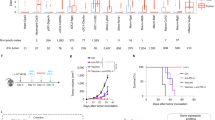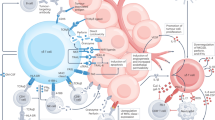Abstract
A phase I clinical trial using autologous, IL-7 gene-modified tumor cells in patients with disseminated melanoma has been recently completed. Although no major clinical responses were observed, increased antitumor cytotoxicity was measured in postvaccine peripheral blood lymphocytes in a subset of treated patients. To analyze the in situ immune response, the T cell receptor β-chain variable region (BV) repertoire of T cells infiltrating postvaccine lesions was studied in two patients, and compared with that of T cells present in prevaccine ones, in peripheral blood lymphocytes, and, in one patient, in delayed type hypersensitivity (DTH) sites of autologous melanoma inoculum. A relative expansion of T cells expressing few BVs was observed in all postvaccine metastases, and their intratumoral presence was confirmed by immunohistochemistry. Length pattern analysis of the complementarity determining region 3 (CDR3) indicated that the repertoire of T cells expressing some of these BVs was heterogeneous. At difference, CDR3, β-chain joining region usage, and sequence analysis enabled us to demonstrate, within a T-cell subpopulation commonly expanded at DTH sites and at the postvaccine lesion of patient 1, that both DTH sites contained identical dominant T-cell clonotypes. One of them was also expressed at increased relative frequency in the postvaccine lesion compared to prevaccine specimens. These results provide evidence for immunological changes, including in situ clonally expanded T cells, in metastases of patients vaccinated with IL-7 gene-transduced cells.
This is a preview of subscription content, access via your institution
Access options
Subscribe to this journal
Receive 12 print issues and online access
$259.00 per year
only $21.58 per issue
Buy this article
- Purchase on Springer Link
- Instant access to full article PDF
Prices may be subject to local taxes which are calculated during checkout





Similar content being viewed by others
References
Wang RF, Rosenberg SA . Human tumor antigens for cancer vaccine development Immunol Rev 1999 170: 85–100
Sun Y, Paschen A, Schadendorf D . Cell-based vaccination against melanoma — background, preliminary results, and perspective J Mol Med 1999 77: 593–608
Marchand M, Weynants P, Rankin E et al. Tumor regression responses in melanoma patients treated with a peptide encoded by gene MAGE-3 Int J Cancer 1995 63: 883–885
Jäger E, Ringhoffer M, Dienes HP et al. Granulocyte–macrophage colony-stimulating factor enhances immune responses to melanoma-associated peptides in vivo Int J Cancer 1996 67: 54–62
Rosenberg SA, Yang JC, Schwartzentruber DJ et al. Immunologic and therapeutic evaluation of a synthetic tumor associated peptide vaccine for the treatment of patients with metastatic melanoma Nat Med 1998 4: 321–327
Scheibenbogen C, Schmittel A, Keilholz U et al. Phase II trial for vaccination with tyrosinase peptides and GM-CSF in melanoma J Immunother 2000 23: 275–281
Nestle FO, Alijagic S, Gilliet M et al. Vaccination of melanoma patients with peptide- or tumor lysate–pulsed dendritic cells Nat Med 1998 4: 328–332
Mackensen A, Herbst B, Chen JL et al. Phase I study in melanoma patients of a vaccine with peptide-pulsed dendritic cells generated in vitro from CD34+ hematopoietic progenitor cells Int J Cancer 2000 86: 385–392
Thurner B, Haendle I, Roder C et al. Vaccination with MAGE-3A1 peptide-pulsed mature, monocyte derived dendritic cells expands specific cytotoxic T cells and induce regression of some metastases in advanced stage IV melanoma J Exp Med 1999 190: 1669–1678
Arienti F, Sule-Suso J, Belli F et al. Limited antitumor T cell response in melanoma patients vaccinated with interleukin-2–transduced allogeneic melanoma cells Hum Gene Ther 1996 7: 1955–1963
Arienti F, Belli F, Napolitano F et al. Vaccination of melanoma patients with interleukin 4 gene–transduced allogeneic melanoma cells Hum Gene Ther 1999 10: 2907–2916
Soiffer R, Lynch T, Mihm M et al. Vaccination with irradiated autologous melanoma cells engineered to secrete human granulocyte–macrophage colony-stimulating factor generates potent antitumor immunity in patients with metastatic melanoma Proc Natl Acad Sci 1998 95: 13141–13146
Möller P, Möller H, Sun Y et al. Vaccination with IL-7 gene-modified autologous melanoma cells can enhance the anti-melanoma lytic activity in peripheral blood of patients with a good clinical performance status — a clinical phase I study Br J Cancer 1998 77: 1907–1916
Sun Y, Jurgovsky K, Moller P et al. Vaccination with IL-12 gene-modified autologous melanoma cells: preclinical results and a first clinical phase I study Gene Ther 1998 5: 481–490
Pannetier C, Even J, Kourilsky P . T-cell repertoire diversity and clonal expansions in normal and clinical samples Immunol Today 1995 16: 176–181
Sensi M, Parmiani G . Analysis of TCR usage in human tumors: a new tool for assessing tumor-specific immune responses Immunol Today 1995 16: 588–595
Thor Straten P, Becker JC, Guldberg P et al. In situ T cells in melanoma Cancer Immunol Immunother 1999 34: 386–395
Mackensen A, Ferradini L, Carcelain G et al. Evidence for in situ amplification of cytotoxic T lymphocytes with antitumor activity in a human regressive melanoma Cancer Res 1993 53: 3569–3573
Sensi M, Salvi S, Castelli C et al. T cell receptor (TCR) structure of autologous melanoma-reactive cytotoxic T lymphocyte (CTL) clones: tumor-infiltrating lymphocytes overexpress in vivo the TCR β chain sequence used by an HLA-A2–restricted and melanocyte-lineage–specific CTL clone J Exp Med 1993 178: 1231–1246
Mackensen A, Carcelain G, Viel S et al. Direct evidence to support the immunosurveillance concept in a human regressive melanoma J Clin Invest 1994 93: 1397–1402
Sensi M, Farina C, Maccalli C et al. Clonal expansion of T lymphocytes in human melanoma metastases after treatment with a hapten-modified autologous tumor vaccine J Clin Invest 1997 99: 710–717
Mackensen A, Veelken H, Lahn M et al. Induction of tumor-specific cytotoxic T lymphocytes by immunization with autologous tumor cells and interleukin-2 gene transfected fibroblasts J Mol Med 1997 75: 290–296
Pisarra P, Mortarini R, Salvi S et al. High frequency of T cell clonal expansions in primary human melanoma. Involvement of a dominant clonotype in autologous tumor recognition Cancer Immunol Immunother 1999 48: 39–46
Angevin E, Kremer F, Gaudin C et al. Analysis of the T-cell immune response in renal cell carcinoma: polarization to type 1-like differentiation pattern, clonal T cell expansion and tumor-specific cytotoxicity Int J Cancer 1997 72: 431–440
Zorn E, Hercend T . A MAGE-6–encoded peptide is recognized by expanded lymphocytes infiltrating a spontaneously regressing human primary melanoma lesion Eur J Immunol 1999 29: 602–607
Zorn E, Hercend T . A natural cytotoxic T cell response in a spontaneously regressing human melanoma targets a neoantigen resulting from a somatic point mutation Eur J Immunol 1999 29: 592–601
Gaudin C, Kremer F, Angevin E et al. A hsp70-2 mutation recognized by CTL on a human renal cell carcinoma J Immunol 1999 162: 1730–1738
Ronsin C, Chung-Scott V, Poullion I et al. A non–AUG-defined alternative open reading frame of the intestinal carboxyl esterase mRNA generates an epitope recognized by renal cell carcinoma–reactive tumor-infiltrating lymphocytes in situ J Immunol 1999 163: 483–490
Altman JD, Moss PA, Goulder PJ et al. Phenotypic analysis of antigen-specific T lymphocytes Science 1996 274: 94–96
Romero P, Dunbar PR, Valmori D et al. Ex vivo staining of metastatic lymph nodes by class I major histocompatibility complex tetramers reveals high numbers of antigen-experienced tumor-specific cytolytic T lymphocytes J Exp Med 1998 188: 1641–1650
Anichini A, Molla A, Mortarini R et al. An expanded peripheral T cell population to a cytotoxic (CTL)-defined, melanocyte-specific antigen in metastatic melanoma patients impacts on generation of peptide-specific CTLs but does not overcome tumor escape from immune surveillance in metastatic lesions J Exp Med 1999 188: 651–667
Nielsen MB, Monsurro V, Migueles SA et al. Status of activation of circulating vaccine–elicited CD8+ T cells J Immunol 2000 165: 2287–2296
Sun Y, Möller P, Berking C et al. In vivo selective expansion of a tumor-specific cytotoxic T-cell clone derived from peripheral blood of a melanoma patient after vaccination with gene-modified autologous tumor cells Immunology 1999 98: 535–540
Möller P, Möller H, Sun Y et al. Increased non–MHC-restricted lytic activity in melanoma patients vaccinated with cytokine gene-transfected autologous tumor cells Cancer Gene Ther 2000 7: 976–984
Hecker KH, Roux KH . High and low annealing temperatures increase both specificity and yield in touchdown and stepdown PCR Biotechniques 1996 20: 478–485
Lupetti R, Pisarra P, Verrecchia A et al. Translation of a retained intron in tyrosinase-related protein (TRP)-2 mRNA generates a new cytotoxic T lymphocyte (CTL)–defined and shared human melanoma antigen not expressed in normal cells of the melanocytic lineage J Exp Med 1998 188: 1005–1016
Genevee C, Diu A, Nierat J et al. An experimentally validated panel of subfamily-specific oligonucleotide primers (Vα1-29/β1-24) for the study of human T cell receptor variable V gene segment usage by polymerase chain reaction Eur J Immunol 1992 22: 1261–1269
Arden B, Clark SP, Kabelitz D et al. Human T-cell receptor variable gene segment families Immunogenetics 1995 42: 455–500
Clemente C, Rao S, Lupetti R et al. Immunohistochemical analysis of the T-cell receptor β-chain variable region expressed by T lymphocytes infiltrating primary human melanoma Lab Invest 1998 78: 619–627
Puisieux I, Even J, Pannetier C et al. Oligoclonality of tumor-infiltrating lymphocytes from human melanomas J Immunol 1994 153: 2807–2818
Moss PA, Bell JI . Sequence analysis of the human α/β T-cell receptor CDR3 region Immunogenetics 1995 42: 10–18
Maccalli C, Farina C, Sensi M et al. TCR β-chain variable region-driven selection and massive expansion of HLA-class I–restricted anti-tumor CTL lines from HLA-A*0201 melanoma patients J Immunol 1997 158: 5902–5913
McKee MD, Clay TM, Diamond RA et al. Quantitation of T-cell receptor frequencies by competitive polymerase chain reaction: dynamics of T-cell clonotype frequencies in an expanding tumor-infiltrating lymphocyte culture J Immunother 2000 23: 419–429
Weidmann E, Logan TF, Yasamura S et al. Evidence of oligoclonal T-cell response in a metastasis of renal cell carcinoma responding to vaccination with autologous tumor cells and transfer of in vitro–sensitized vaccine-draining lymphnode lymphocytes Cancer Res 1993 53: 4745–4749
Farace F, Angevin E, Poullion I et al. T-cell receptor CDR3 size distribution analysis to evaluate specific T-cell response to cancer vaccine Int J Cancer 1997 71: 972–977
Waanders GA, Rimoldi D, Lienard D et al. Melanoma-reactive human cytotoxic T lymphocytes derived from skin biopsies of delayed-type hypersensitivity reactions induced by injection of an autologous melanoma cell line Clin Cancer Res 1997 3: 685–696
Acknowledgements
This work was supported by grants from the Italian Association for Cancer Research (AIRC, Milan) and Italy–USA Program on Therapy of Tumors and by a grant of the DFG (422/6-2).
Author information
Authors and Affiliations
Corresponding author
Rights and permissions
About this article
Cite this article
Carsana, M., Tragni, G., Nicolini, G. et al. Comparative assessment of TCRBV diversity in T lymphocytes present in blood, metastatic lesions, and DTH sites of two melanoma patients vaccinated with an IL-7 gene-modified autologous tumor cell vaccine. Cancer Gene Ther 9, 243–253 (2002). https://doi.org/10.1038/sj.cgt.7700435
Received:
Published:
Issue Date:
DOI: https://doi.org/10.1038/sj.cgt.7700435



